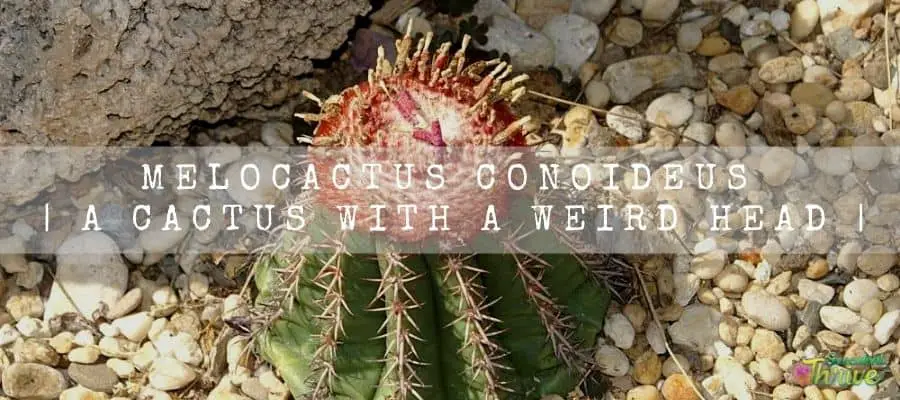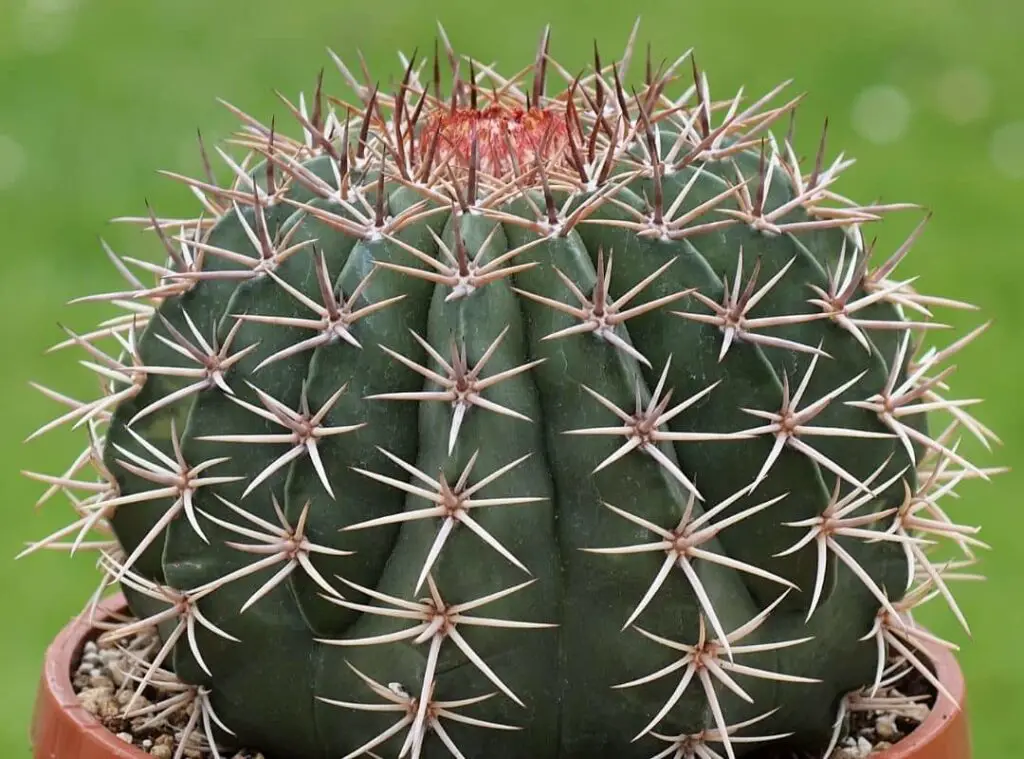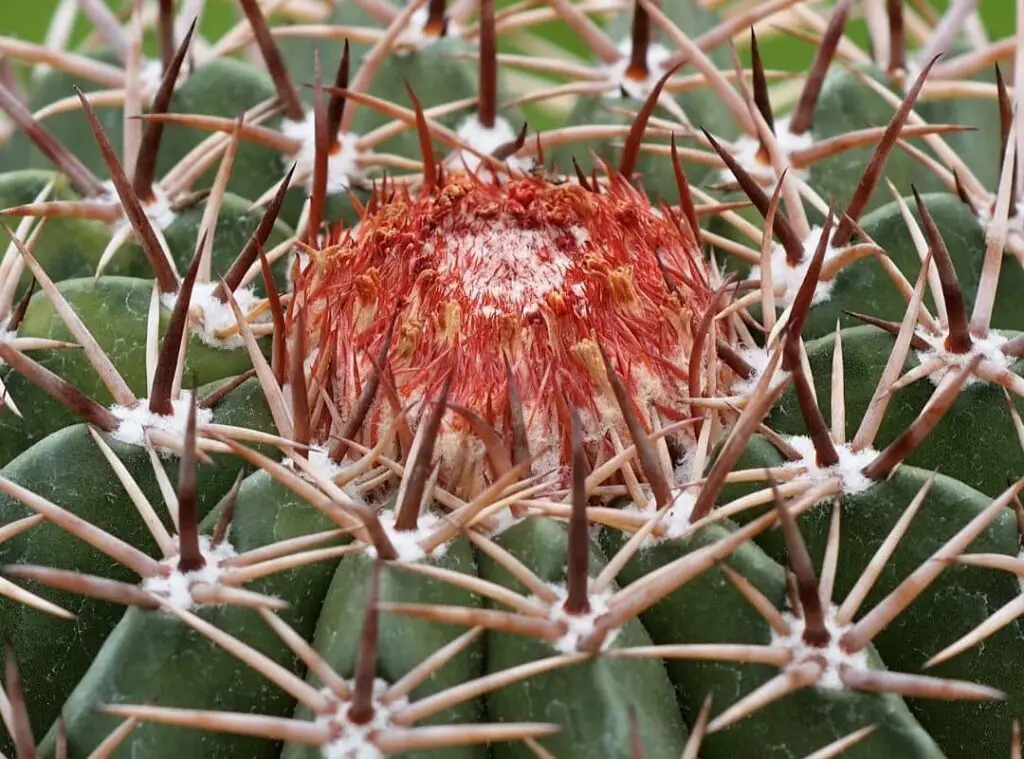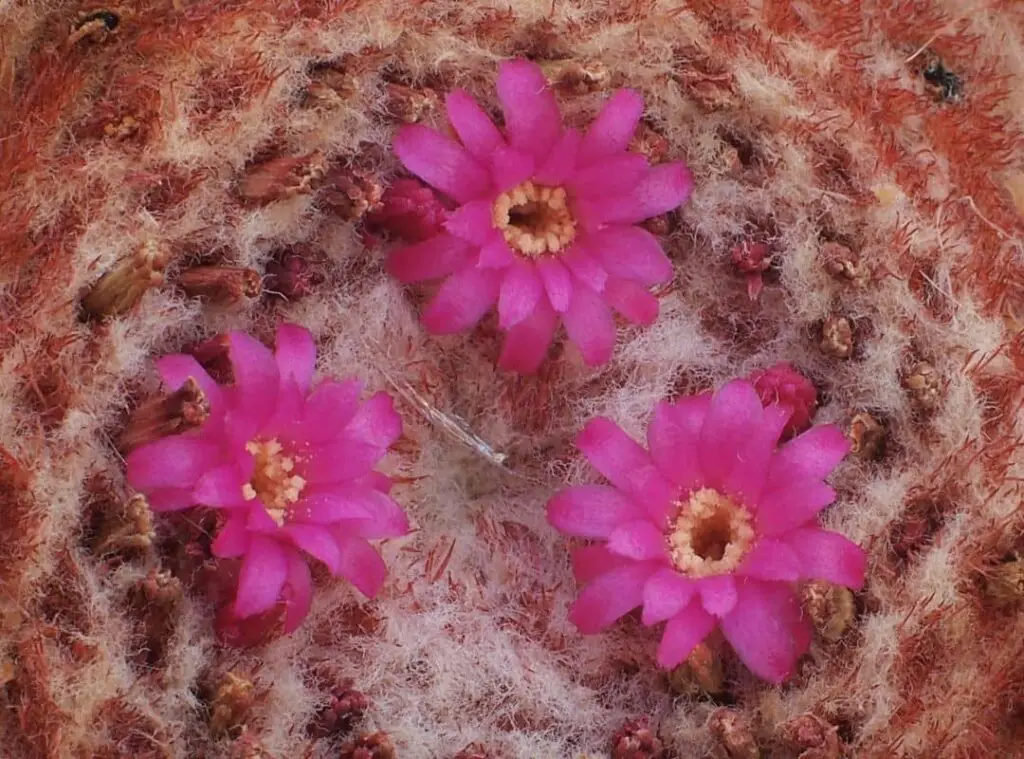Melocactus conoideus are endemic plants to Brazil. They would usually form 900-1200 m above sea level.
You could spot them growing in rocky uplands, dry thorn forests. Melocactus conoideus would usually grow along with shrubs and with herbs. You could commonly spot the Melocactus conoideus grown with Melocactus conncinnus.
‘Cone-like Turk’s head cactus’ is their common name. They belong to the cactaceae family. Melocactus conoideus require somewhat difficult maintenance and it would suit the experienced gardeners the best.

How do I identify Melocactus conoideus?
It contain a short spine. Further their stem would be strongly depressed or hemispherical or colonial.
They would be 10 cm in height and 17 cm in diameter. Moreover, Melocactus conoideus would consist of 11-14 ribs. Those ribs are very low and round in shape.
It has areoles too. They are small and tend to resemble the look of cushions. Those areolas would form 15 mm apart.
You could spot Melocactus conoideus carrying a central spine. It would be 20-22 mm long and 1.5 mm in width at the base. They would be straight to slightly recurved.
They contain radial spines. They would mainly be brown. However, their tips would be gray and tend to take a slightly curved shape.
They contains a cephalium which is fairly short. They would usually be less than 3 cm in height and 7.5 cm in diameter. They would be reddish and contain bristles as well. Besides they would contain white wool too.
In addition to these, Melocactus conoideus produce flowers in pink or in magenta. In terms of the sizes, they would be 22 mm long and 10 mm in diameter.
The flower stigma would be white. You could spot them producing flowers in anthesis.
Besides, Melocactus conoideus produces a fruit which is in lilac magenta. They would be 18-21 mm in length and 5-6 mm in width. They would arise from the cephalium. Those fruits contain seeds too.
Growth rate
Melocactus conoideus are slow growing plants and it is somewhat challenging to grow them.
One look care guide
| Botanical Name | Melocactus conoideus |
| Common Name | ‘Cone-like Turk’s head cactus’ |
| Plant Type | cactus |
| Mature Size | 6 inches ( 15 cm ) in height. |
| Sun Exposure | Full sunlight to partial shade |
| Soil Type | Well-draining / Sandy |
| Soil pH | Slightly acidic to neutral |
| Bloom Time | Anthesis |
| Flower Color | pink or in magenta. They |
| Hardiness Zones | USDA hardiness zones 9b to 11. |
| Native Area | Brazil |
| Toxicity | Non toxic |
| Average price | $ 6 – 10 |

How do you take care of Melocactus conoideus?
Light Requirement
Ensure that you expose these beauties for full sunlight in the morning and light shade during intense afternoon hours.
Exposure for six hours for full sunlight would help the plant’s healthy growth. When you add them as indoor plants, choose a bright sunny window and if possible, you may bring them outside for some time during summer.
Temperature and humidity
Tropical temperatures would work well with the Melocactus conoideus.
Melocactus conoideus cannot withstand cold and chances are that frost may even bring fatal impact on the plants.
Ideally, you need to expose them for temperatures above 70 degrees Fahrenheit and refrain from exposing them for temperatures below 60 degrees Fahrenheit.
Moreover, do not place the plants closer to cold drafts and air conditioners. Melocactus conoideus are not very picky in terms of humidity as long as you grow them in a well-draining soil mix.
Is it cold hardy?
Melocactus conoideus do not handle cold well.
USDA Hardiness Zone
Melocactus conoideus prefers to grow in USDA hardiness zones 9b to 11.

Watering Requirement
Always make sure that you allow the soil to dry between two watering sessions when watering them.
Having said that, do not ever leave them to be bone dry. On the other hand, excess water will also lead to root rot. Literally their roots cannot suck water from wet soil.
They would prefer to have moderate water levels. If you feel like their soil is dry, you can consider giving them some water.
Further once you complete watering ensure that all excess water is draining away from the draining holes in the pot. They are used to grow in drought conditions and keep that in mind when watering them always.
Soil Requirement Type / pH
Melocactus conoideus prefers to have a substrate which has an excellent drainage.
Hence, a sandy or a rocky soil mix would be ideal for them. If you end up growing them in a poor draining soil mix, it will lead to root rot.
You may consider using a cactus potting mix to grow them. Otherwise, a soil mix which has 75 % healthier soil and 25 % coarse sand would work well with them.
When it comes to the right ph. levels, a slightly acidic or neutral ph. would be healthy for the vigorous growth of the Melocactus conoideus.
Pot size Potting and Repotting
You need to go ahead with a pot which has ample drainage for the Melocactus conoideus.
They don’t mind growing a little cramped. However, the best is to choose a pot which is slightly larger than the root ball.
In terms of the right pot material, an unglazed clay pot would suit them the best as there will be no excess moisture retained within the pot.
I do not recommend repotting them too often as they have a weak root system. You need to consider repotting them, If you spot them outgrown from the pots.
To repot them, you can simply first remove the root ball from the container and clean the older soil around the roots. Next you can replant them in a fresh pot in the same depth as you grew them in the older pot.
Where to Plant
Choose a spot where you can fulfill the sunlight requirement of the Melocactus conoideus as they have a strong demand when it comes to sunlight.
Fertilizer and time of year
Consider feeding the Melocactus conoideus with a balanced cactus or a succulent fertilizer.
Best is to feed them in spring or in summer so that it would encourage the growth of them. Refrain from feeding them in fall and in winter as it is not necessary.
You need to choose a fertilizer which has a low component of Nitrogen and always adhere to the labeled instructions when applying the fertilizers. Refrain from over feeding the Melocactus conoideus as it would result in feed burns in them.
Flower
You could spot the Melocactus conoideus blossoming flowers during Anthesis. They would bloom in magenta color.

Dormancy
Toxicity
Melocactus conoideus are not toxic plants.
Common bugs and illnesses
Melocactus conoideus are somewhat prone for domestic pests’ attacks. Ideally you need to watch out for pests such as red spider mites, mealy bugs etc. To elaborate further on this,
You could spot the mealybugs occasionally on new growths of the plants. However, scales would hardly invade these plants. If you end up over watering the Melocactus conoideus, it will pave the way for root rot which could be sometimes fatal on the plants.
Special Care tips
I recommend wearing gloves when interacting with the plants as they contain spines.
How to propagate Melocactus conoideus
You can propagate the Melocactus conoideus by seeds. You can simply sow them in a light sandy soil mix during February to March.
Conclusion
To wind up, trust this article gives you a broader view of how you should take care of these plants well and how you should propagate them.
Read Next : Melocactus Bahiensis | A Cactus With Weird Head | Melocactus Intortus | A Cactus With A Weird Head | Melocactus Curvispinus | Cactus With A Weird Head |
